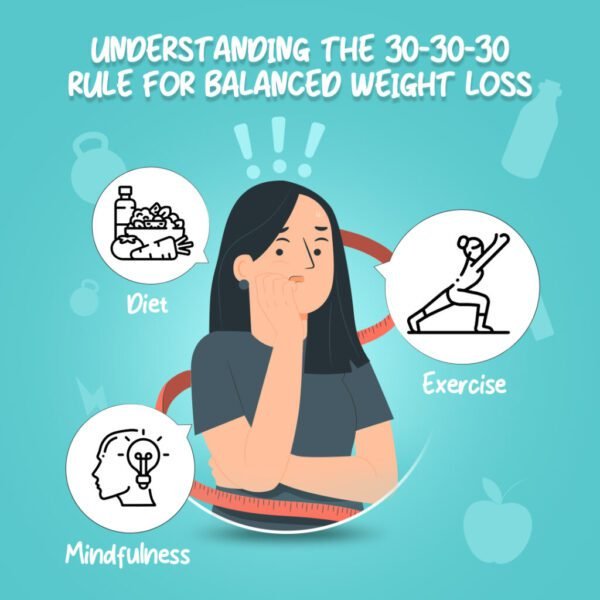Tired of the endless cycle of restrictive diets and grueling workouts that promise fat loss but often leave you feeling drained and discouraged? In the quest for a leaner, healthier body, it’s easy to get lost in a sea of complex strategies and conflicting advice. But what if there was a simple, actionable routine you could incorporate into your daily life that could potentially boost fat burning and improve your overall well-being?
Enter the “30-30-30 rule”. This straightforward concept, often credited to biohacking guru Tim Ferriss, proposes a powerful one-two punch to kickstart your metabolism and set you up for a successful day. It’s surprisingly simple: consume 30 grams of protein within 30 minutes of waking, followed by 30 minutes of low-intensity exercise.
While it might sound almost too easy, the 30-30-30 rule taps into some key principles of nutrition and exercise physiology. In this article, we’ll delve into the science behind this intriguing strategy, exploring how prioritizing protein intake early and engaging in gentle movement can potentially unlock your body’s fat-burning potential and contribute to a healthier, more energized you. Get ready to discover if the 30-30-30 rule could be the simple yet effective addition your fat-loss journey has been waiting for.
Breaking Down the 30-30-30 Rule
At its heart, the 30-30-30 rule is elegantly simple, a trifecta of time and action designed to work synergistically. Let’s dissect each component to understand the “why” behind this potentially powerful habit.
The First “30”: 30 Grams of Protein Within 30 Minutes of Waking
Think of your body as a finely tuned machine. After a night of fasting, it’s craving fuel to get going. The first “30” of the rule emphasizes the strategic delivery of 30 grams of high-quality protein within the first 30 minutes of you opening your eyes. This isn’t just about breaking your overnight fast; it’s about sending a powerful signal to your body right from the start.
Why protein, and why so soon? Protein is a nutritional powerhouse, playing a crucial role in numerous bodily functions, especially when it comes to managing weight and building or preserving lean muscle mass. Consuming it early in the day offers several key advantages:
• Satiety Superstar: Protein is incredibly satiating, meaning it helps you feel fuller for longer compared to carbohydrates or fats. By front-loading your protein intake, you’re more likely to curb those mid-morning cravings and avoid reaching for sugary snacks or calorie-dense, less nutritious options. This can have a significant impact on your overall calorie intake throughout the day, a cornerstone of effective fat loss.
• Muscle Protein Synthesis (MPS): While MPS occurs throughout the day, consuming protein, especially after a period of fasting (like sleep), provides the necessary amino acid building blocks to kickstart muscle repair and growth. Maintaining and building lean muscle is vital for a healthy metabolism, as muscle tissue burns more calories at rest than fat tissue.
• The Thermic Effect of Food (TEF): Your body expends energy to digest, absorb, and metabolize the nutrients you consume. Protein has a significantly higher TEF compared to carbohydrates and fats. This means your body actually burns more calories processing protein, contributing to a slight but consistent increase in your daily energy expenditure.
• Appetite Regulation: Early protein intake can influence the release of hormones that regulate appetite, such as ghrelin (the “hunger hormone”) and peptide YY (a hormone that promotes fullness). By keeping ghrelin at bay and boosting peptide YY, you’re setting yourself up for better appetite control throughout the day.



So, how do you practically achieve this 30-gram protein goal within that crucial first half-hour? The key is to have readily available and convenient options. Think beyond the traditional sugary cereals and pastries. Consider:
• Protein Shakes: A quick and easy way to hit your target, especially if you use a quality protein powder (whey, casein, soy, or plant-based blends).
• Eggs: Versatile and packed with protein. Two to three large eggs can easily provide around 12-18 grams of protein, and you can pair them with other protein sources.
• Greek Yogurt: A creamy and delicious option, often boasting upwards of 20 grams of protein per serving. Add some nuts or seeds for an extra boost.
• Cottage Cheese: Another excellent source of protein that can be enjoyed on its own or with fruit.
• Leftovers: Don’t shy away from lean protein sources from dinner, like grilled chicken or fish.
Planning ahead is crucial here. Having your protein source readily available will make it much easier to adhere to the 30-minute window, setting the stage for the second part of the rule.
The Second “30”: 30 Minutes of Low-Intensity Exercise
With your body fueled by protein, the next step in the 30-30-30 rule is to engage in 30 minutes of low-intensity exercise. This might seem counterintuitive to those who believe that only high-intensity workouts lead to significant fat burning. However, the beauty of this component lies in its sustainability and its specific impact on how your body utilizes energy.
Low-intensity exercise generally refers to activities where you can comfortably hold a conversation. Think:
• Brisk Walking: A simple yet highly effective way to get your body moving.
• Light Cycling: An excellent option that’s gentle on the joints.
• Yoga or Pilates: Focus on slower, controlled movements.
• A Gentle Hike: Enjoy the outdoors while getting your body moving.



Why low-intensity exercise in the morning, particularly after consuming protein?
• Enhanced Fat Oxidation: When you engage in low-intensity exercise, especially in a fasted state (before a large carbohydrate-rich meal) or after consuming protein (which doesn’t significantly spike blood sugar), your body is more likely to tap into its fat stores for energy. This process, known as fat oxidation, can be more pronounced during lower intensity activities compared to high-intensity workouts, where your body primarily relies on glycogen (stored carbohydrates) for fuel.
• Improved Insulin Sensitivity: Both protein intake and exercise play a role in improving insulin sensitivity. When your body is more sensitive to insulin, it can more effectively shuttle glucose from your bloodstream into your cells for energy, rather than storing it as fat. This is particularly beneficial in the morning after a period of fasting.
• Stress Reduction and Mood Boost: Low-intensity exercise can help lower cortisol levels, the stress hormone, which can be elevated in the morning. Gentle movement can also release endorphins, those feel-good chemicals that can improve your mood and set a positive tone for the day.
• Accessibility and Sustainability: Unlike demanding high-intensity workouts, 30 minutes of low-intensity exercise is generally more accessible to a wider range of fitness levels and is easier to incorporate consistently into your daily routine. Consistency is key when it comes to long-term fat loss and overall health.
The goal here isn’t to push yourself to your limits or break a sweat. It’s about gentle, consistent movement that complements the protein intake, encouraging your body to utilize fat for fuel and improving metabolic health.
By understanding the individual components of the 30-30-30 rule, we begin to see how this seemingly simple strategy can have a multifaceted impact on your body, potentially paving the way for more effective fat loss and a healthier lifestyle. In the next chapter, we’ll delve deeper into the scientific principles that underpin these benefits.
The Science Behind the Benefits (Connecting to Fat Loss)
While the 30-30-30 rule might seem like a straightforward set of instructions, its potential effectiveness in promoting fat loss and overall health is rooted in several well-established physiological principles. Let’s delve into the science that underpins these benefits and how they directly relate to your fat-burning goals.
Protein and Satiety: The Hunger-Crushing Powerhouse
As we touched upon in the previous chapter, protein is a satiety superstar. When you consume 30 grams of protein within that first half-hour of your day, you’re sending strong signals to your brain that you’re satisfied. This happens through several mechanisms:
• Hormonal Signals: Protein intake stimulates the release of gut hormones like peptide YY (PYY) and glucagon-like peptide-1 (GLP-1). These hormones play a crucial role in signaling fullness to the brain and slowing down gastric emptying, meaning food stays in your stomach longer, further contributing to feelings of satiety.
• Reduced Ghrelin: Conversely, protein consumption can help suppress the production of ghrelin, often referred to as the “hunger hormone.” By keeping ghrelin levels in check, you’re less likely to experience those nagging feelings of hunger that can lead to impulsive and less healthy food choices later in the day.
• Impact on Brain Chemistry: Amino acids, the building blocks of protein, can influence neurotransmitters in the brain that are involved in appetite regulation and reward pathways. This can help reduce cravings and the desire for highly palatable, often calorie-dense foods.
By starting your day with a significant dose of protein, you’re essentially setting yourself up for better appetite control throughout the day, making it easier to adhere to a calorie deficit – a fundamental requirement for fat loss.
The Thermic Effect of Food (TEF): Burning Calories Just by Eating
Not all calories are created equal when it comes to how your body processes them. The thermic effect of food (TEF) refers to the energy your body expends to digest, absorb, and metabolize the nutrients you consume. Protein boasts a significantly higher TEF compared to carbohydrates and fats, typically ranging from 20-35% of its caloric content.
This means that for every 100 calories of protein you eat, your body might burn 20-35 calories just in the process of breaking it down. While this might not seem like a huge number in isolation, consistently choosing protein-rich foods, especially early in the day, can contribute to a noticeable increase in your overall daily energy expenditure over time, aiding in your fat-loss efforts.
Muscle Preservation and Building: Your Metabolic Allies
When you’re aiming to lose fat, it’s crucial to preserve as much lean muscle mass as possible. Muscle tissue is metabolically active, meaning it burns more calories at rest than fat tissue. Consuming adequate protein, particularly in conjunction with exercise, provides the necessary amino acids to support muscle protein synthesis (MPS), the process of repairing and building muscle.
By prioritizing protein intake in the morning, you’re providing your body with the building blocks it needs to maintain and potentially even build muscle, especially when followed by the low-intensity exercise component of the rule. Preserving and building muscle helps to elevate your basal metabolic rate (BMR), the number of calories your body burns at rest, making it easier to create and maintain a calorie deficit for fat loss.
Fat Oxidation During Low-Intensity Exercise: Tapping into Your Energy Reserves
The second “30” of the rule focuses on low-intensity exercise, and while it might not feel as calorie-burning intensive as a high-impact workout, it plays a crucial role in fat utilization. During prolonged, low-intensity activity, your body relies more heavily on fat stores for energy compared to high-intensity exercise, where carbohydrates (glycogen) are the primary fuel source.
This effect can be further amplified when performed in a fasted state or after consuming protein, which doesn’t significantly deplete glycogen stores. By engaging in that 30-minute brisk walk or light cycle after your protein-rich breakfast, you’re encouraging your body to tap into its fat reserves for fuel.
Blood Sugar Control and Insulin Sensitivity: Preventing Fat Storage
Both protein intake and exercise have a positive impact on blood sugar regulation and insulin sensitivity. When you eat carbohydrates, they are broken down into glucose, which enters your bloodstream. Insulin is a hormone that helps move this glucose into your cells for energy or storage.
Consuming protein has a minimal impact on blood sugar levels compared to carbohydrates. Furthermore, regular exercise, even low-intensity, can improve your body’s sensitivity to insulin, meaning your cells become more responsive to insulin’s signals, allowing glucose to be used more efficiently and reducing the likelihood of it being stored as fat.
By combining protein intake with low-intensity exercise in the morning, you’re creating a metabolic environment that favors stable blood sugar levels and improved insulin sensitivity, both of which are crucial for preventing excessive fat storage and promoting fat burning.
In essence, the 30-30-30 rule isn’t just a random combination of numbers. It’s a strategically designed routine that leverages the power of protein for satiety and muscle support, and the benefits of low-intensity exercise for fat oxidation and metabolic health. When implemented consistently, this simple rule can be a valuable tool in your arsenal for achieving sustainable fat loss and improving your overall well-being. In the next chapter, we’ll move on to practical tips for effectively implementing this rule into your daily life.
Implementing the 30-30-30 Rule Effectively
Understanding the science behind the 30-30-30 rule is one thing; putting it into practice consistently is where the real magic happens. Here are some practical tips to help you seamlessly integrate this simple yet powerful strategy into your daily routine and maximize its potential benefits.
Practical Tips for the Protein Component: Fueling Your Morning the Right Way
Hitting that 30-gram protein target within the first 30 minutes of waking requires a bit of planning and foresight. Here are some strategies to make it a breeze:
• Plan Ahead: The biggest hurdle is often time, especially in the morning rush. What will your go-to protein sources be? Keep them stocked and easily accessible.
• Embrace Convenience: Don’t overcomplicate things. Quick and easy options are your best friend, especially on busy days.
o Protein Powders: A scoop of quality protein powder mixed with water, milk (dairy or non-dairy), or added to a quick smoothie is a fantastic way to hit your 30-gram mark efficiently.
o Pre-Portioned Options: Consider pre-portioning Greek yogurt into containers or hard-boiling a batch of eggs at the beginning of the week.
o Ready-to-Eat Items: Look for convenient options like pre-cooked chicken strips or smoked salmon that can be quickly added to a simple breakfast.
• Think Versatility: Your morning protein doesn’t have to be boring. Explore different options to keep things interesting:
o Smoothies: Blend protein powder with fruits, vegetables, and healthy fats for a nutrient-dense and satisfying meal.
o Omelets or Scrambles: Eggs are a protein powerhouse and can be combined with vegetables and a sprinkle of cheese.
o Cottage Cheese with Toppings: Add berries, nuts, or a drizzle of honey for flavor and added nutrients.
o Overnight Oats with Protein Powder: Prepare your oats the night before and stir in protein powder in the morning.
• Hydration is Key: Remember to drink water alongside your protein-rich breakfast. Staying hydrated is crucial for overall health and can also contribute to feelings of fullness.
Practical Tips for the Exercise Component: Making Movement a Morning Ritual
The 30 minutes of low-intensity exercise should feel manageable and enjoyable, something you can consistently look forward to. Here’s how to make it a sustainable part of your morning:
• Find Activities You Enjoy: The key to consistency is choosing activities you genuinely like. Whether it’s a brisk walk in your neighborhood, a leisurely bike ride, a calming yoga session, or even some light gardening, find something that feels more like a pleasant activity than a chore.
• Incorporate it into Your Routine: Make your 30 minutes of movement a non-negotiable part of your morning, just like brushing your teeth. Schedule it in your calendar if that helps.
• Keep it Accessible: Choose activities that don’t require a lot of equipment or travel time. A walk outside your door or a yoga mat in your living room are ideal.
• Listen to Your Body: Low-intensity means you should be able to hold a conversation comfortably. Don’t push yourself too hard, especially in the beginning. The goal is consistent movement, not exhaustion.
• Consider the Timing: Experiment to see what works best for you. Some might prefer to exercise immediately after their protein, while others might wait a little while. The important thing is to get it done within a reasonable timeframe after your morning protein.
• Break it Up (If Necessary): If a full 30 minutes feels daunting initially, you can even break it into two 15-minute sessions throughout the morning. The benefits still accrue.
Listen to Your Body: The Ultimate Guide
While the 30-30-30 rule provides a framework, remember that your body is unique. Pay attention to how you feel when implementing this routine.
• Energy Levels: Do you feel more energized throughout the day?
• Hunger and Cravings: Are you experiencing better appetite control?
• Digestion: Is your digestive system responding well to the increased protein intake?
• Overall Well-being: How does this routine make you feel mentally and physically?
Don’t be afraid to make minor adjustments based on your individual needs and responses. If 30 grams of protein feels like too much initially, you can gradually work your way up. If a particular type of exercise doesn’t feel right, try something else. The goal is to find a sustainable approach that works for you.
Hydration: The Unsung Hero
Throughout this process, don’t underestimate the importance of staying adequately hydrated. Water plays a crucial role in metabolism, energy levels, and overall bodily functions. Make sure you’re drinking enough water throughout the day, especially after your protein intake and during your exercise.
By following these practical tips and remaining attuned to your body’s signals, you can effectively implement the 30-30-30 rule and harness its potential benefits for fat loss and a healthier, more energized life. In the next chapter, we’ll explore some of the additional benefits you might experience beyond just weight management.
Beyond Fat Loss: Potential Benefits and Important Considerations of the 30-30-30 Rule
While the primary focus for many drawn to the 30-30-30 rule is its potential for fat loss, this simple strategy may offer a range of additional benefits. However, like any dietary and exercise approach, it’s crucial to consider its potential drawbacks and whether it aligns with individual needs and lifestyles.
Potential Benefits Beyond Fat Loss:
Beyond its impact on metabolism and fat burning, the consistent practice of the 30-30-30 rule may contribute to several other aspects of well-being:
• Increased and More Stable Energy Levels: Starting your day with a protein-rich meal can help stabilize blood sugar levels, preventing the energy crashes often associated with high-carbohydrate breakfasts. Combined with the energizing effects of morning exercise, this routine can lead to more sustained energy throughout the day.
• Improved Mood and Focus: Both protein intake (through its influence on neurotransmitters) and exercise (through the release of endorphins) have been linked to improved mood and cognitive function. Establishing this positive routine early in the day can set a more focused and positive tone for the hours ahead.
• Better Sleep Quality: A consistent daily routine, including regular morning exercise, can contribute to better regulation of your body’s natural sleep-wake cycle (circadian rhythm). Furthermore, stable blood sugar levels throughout the day can help prevent nighttime disruptions caused by blood sugar fluctuations.
• Enhanced Muscle Recovery: Consuming protein shortly after waking can help kickstart muscle repair and recovery, especially if you engaged in more intense exercise the previous day. The subsequent low-intensity exercise can also improve blood flow to the muscles, aiding in recovery.
• Development of Healthy Habits: The 30-30-30 rule encourages the establishment of two positive habits – prioritizing protein intake and engaging in regular physical activity – early in the day. This can create a positive ripple effect, making it easier to adopt other healthy behaviors throughout the day.
Considerations and Potential Drawbacks:
While the 30-30-30 rule offers several potential advantages, it’s essential to be aware of its limitations and potential drawbacks:
• Individual Needs and Dietary Restrictions: The recommendation of 30 grams of protein in the morning might not be suitable for everyone. Individuals with certain kidney conditions or specific dietary restrictions (e.g., veganism, allergies) may need to modify their protein sources and amounts. It’s always advisable to consult with a healthcare professional or registered dietitian if you have any underlying health conditions or specific dietary needs.
• Protein Intake Goals: While 30 grams of protein in the morning is a good starting point, overall daily protein needs vary based on factors like activity level, age, and muscle mass goals. The 30-30-30 rule addresses the morning intake but doesn’t encompass total daily protein requirements.
• Not a “Magic Bullet”: It’s crucial to understand that the 30-30-30 rule is a helpful tool but not a standalone solution for fat loss or optimal health. Sustainable results require a holistic approach that includes a balanced and nutrient-dense diet, adequate sleep, stress management, and potentially other forms of exercise. Relying solely on this rule without addressing other lifestyle factors may limit its effectiveness.
• Time Commitment: While 30 minutes of exercise might seem manageable, finding that extra half-hour in a busy morning can be a challenge for some individuals. Creative scheduling and prioritizing may be necessary.
• Potential for Misinterpretation: Some individuals might view the “low-intensity” aspect as permission to do very little. While gentle movement is encouraged, it should still be purposeful and elevate your heart rate slightly to reap the metabolic benefits.
• Listen to Your Body (Reiterated): As emphasized before, paying attention to your body’s signals is paramount. If you experience any discomfort, digestive issues, or persistent fatigue while following this rule, it’s important to reassess and potentially adjust your approach.
• Sustainability: While the rule is simple, its long-term sustainability depends on individual preferences and lifestyles. If the protein sources or exercise choices feel restrictive or unenjoyable, adherence may become difficult over time. Finding enjoyable and sustainable options for both components is key.
In conclusion, the 30-30-30 rule offers a potentially effective and relatively simple strategy for boosting fat loss and improving overall well-being. However, it’s crucial to consider individual needs, understand its limitations, and integrate it as part of a comprehensive and sustainable approach to health and fitness. By weighing the potential benefits against the considerations, you can make an informed decision about whether and how to incorporate this rule into your lifestyle.
Making the 30-30-30 Rule Work for You
The 30-30-30 rule, with its simple yet strategic focus on morning protein intake and low-intensity exercise, offers a compelling and accessible approach to potentially enhance fat loss and improve overall health. By prioritizing 30 grams of protein within the first 30 minutes of your day, you can leverage its powerful effects on satiety, metabolism, and muscle support. Following this with 30 minutes of gentle movement can further encourage fat oxidation, improve insulin sensitivity, and contribute to increased energy and a positive mindset.
While not a magic bullet, the science underpinning the 30-30-30 rule suggests it can be a valuable tool in your journey towards a leaner, healthier you. Its beauty lies in its simplicity and the way it encourages the establishment of positive habits right from the start of your day.
However, remember that individual needs and lifestyles vary. The 30-30-30 rule should be viewed as a guideline, and listening to your body is paramount. Adjust protein sources and exercise activities to suit your preferences and any dietary requirements or health considerations you may have. Ultimately, sustainable success in fat loss and well-being comes from a holistic approach that encompasses a balanced diet, consistent physical activity, adequate rest, and mindful habits.
So, is the 30-30-30 rule the missing piece in your puzzle? Why not experiment and see how this straightforward strategy integrates into your daily life? By embracing this simple morning routine, you might just unlock a more effective path to burning fat, boosting your energy, and cultivating a healthier, happier you.
Now, we’d love to hear from you! Have you tried the 30-30-30 rule? What are your thoughts or experiences? Share your comments and questions below!



